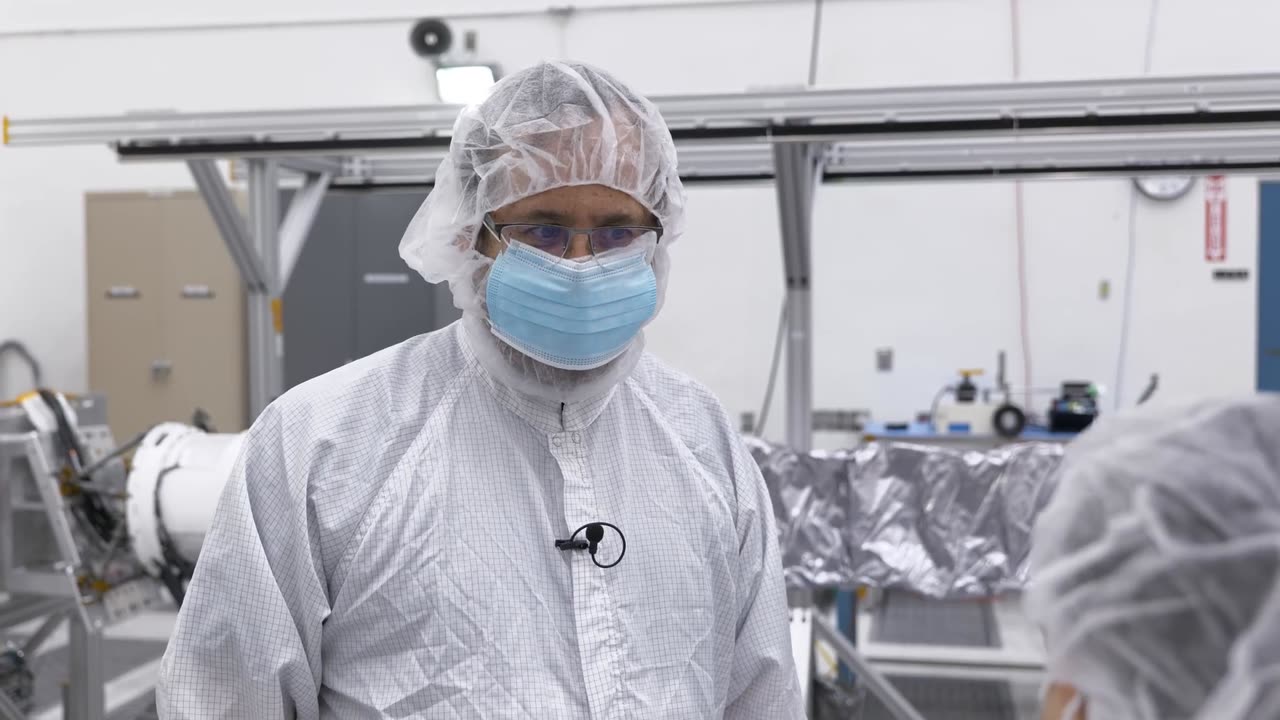Premium Only Content

Spacecraft Makers: Testing Europa Clipper’s Magnetometer
#spacecraft #spacecraftmakers #testingeuropaclippers #europaclippers #magnetometer #nasa #nasaspacemission #nasa2030 #spacecraft2030 #jetpropulsion #launch #jupiter #jupiterexploration #jupiterjourney #spaceexploration #wc1 #wolfchamp
Spacecraft Makers: Testing Europa Clipper’s Magnetometer
Join team members from NASA’s Europa Clipper mission in a clean room at NASA’s Jet Propulsion Laboratory to learn about testing of the spacecraft’s magnetometer, which will help scientists answer the question, “Does Europa have an ocean?”
The magnetometer is made up of a long, 28-foot (6.5-meter) boom and three fluxgate sensors, which are compressed in a canister on the side of the spacecraft until the boom is deployed after launch. The electronics for the instrument are contained in the vault of the spacecraft, along with electronics for the other science instruments.
Spacecraft Makers is a video series that takes audiences behind the scenes to learn more about how space missions, like Europa Clipper, come together. Europa Clipper will explore this icy moon of Jupiter to see if there are conditions suitable for life. Scientists have evidence that a global ocean lies under the moon’s surface, and the mission aims to confirm the existence of the ocean.
The spacecraft needs to be hardy enough to survive a 1.6-billion-mile, six-year journey to Jupiter – and sophisticated enough to perform a detailed science investigation of Europa once it arrives at the Jupiter system in 2030.
Europa Clipper is expected to launch in October 2024 from Kennedy Space Center in Florida.
Spacecraft Makers: Testing Europa Clipper’s Magnetometer
Join team members from NASA’s Europa Clipper mission in a clean room at NASA’s Jet Propulsion Laboratory to learn about testing of the spacecraft’s magnetometer, which will help scientists answer the question, “Does Europa have an ocean?”
The magnetometer is made up of a long, 28-foot (6.5-meter) boom and three fluxgate sensors, which are compressed in a canister on the side of the spacecraft until the boom is deployed after launch. The electronics for the instrument are contained in the vault of the spacecraft, along with electronics for the other science instruments.
Spacecraft Makers is a video series that takes audiences behind the scenes to learn more about how space missions, like Europa Clipper, come together. Europa Clipper will explore this icy moon of Jupiter to see if there are conditions suitable for life. Scientists have evidence that a global ocean lies under the moon’s surface, and the mission aims to confirm the existence of the ocean.
The spacecraft needs to be hardy enough to survive a 1.6-billion-mile, six-year journey to Jupiter – and sophisticated enough to perform a detailed science investigation of Europa once it arrives at the Jupiter system in 2030.
Europa Clipper is expected to launch in October 2024 from Kennedy Space Center in Florida.
Spacecraft Makers: Testing Europa Clipper’s Magnetometer
Join team members from NASA’s Europa Clipper mission in a clean room at NASA’s Jet Propulsion Laboratory to learn about testing of the spacecraft’s magnetometer, which will help scientists answer the question, “Does Europa have an ocean?”
The magnetometer is made up of a long, 28-foot (6.5-meter) boom and three fluxgate sensors, which are compressed in a canister on the side of the spacecraft until the boom is deployed after launch. The electronics for the instrument are contained in the vault of the spacecraft, along with electronics for the other science instruments.
Spacecraft Makers is a video series that takes audiences behind the scenes to learn more about how space missions, like Europa Clipper, come together. Europa Clipper will explore this icy moon of Jupiter to see if there are conditions suitable for life. Scientists have evidence that a global ocean lies under the moon’s surface, and the mission aims to confirm the existence of the ocean.
The spacecraft needs to be hardy enough to survive a 1.6-billion-mile, six-year journey to Jupiter – and sophisticated enough to perform a detailed science investigation of Europa once it arrives at the Jupiter system in 2030.
Europa Clipper is expected to launch in October 2024 from Kennedy Space Center in Florida.
Spacecraft Makers: Testing Europa Clipper’s Magnetometer
Join team members from NASA’s Europa Clipper mission in a clean room at NASA’s Jet Propulsion Laboratory to learn about testing of the spacecraft’s magnetometer, which will help scientists answer the question, “Does Europa have an ocean?”
The magnetometer is made up of a long, 28-foot (6.5-meter) boom and three fluxgate sensors, which are compressed in a canister on the side of the spacecraft until the boom is deployed after launch. The electronics for the instrument are contained in the vault of the spacecraft, along with electronics for the other science instruments.
Spacecraft Makers is a video series that takes audiences behind the scenes to learn more about how space missions, like Europa Clipper, come together. Europa Clipper will explore this icy moon of Jupiter to see if there are conditions suitable for life. Scientists have evidence that a global ocean lies under the moon’s surface, and the mission aims to confirm the existence of the ocean.
The spacecraft needs to be hardy enough to survive a 1.6-billion-mile, six-year journey to Jupiter – and sophisticated enough to perform a detailed science investigation of Europa once it arrives at the Jupiter system in 2030.
Europa Clipper is expected to launch in October 2024 from Kennedy Space Center in Florida.
Spacecraft Makers: Testing Europa Clipper’s Magnetometer
Join team members from NASA’s Europa Clipper mission in a clean room at NASA’s Jet Propulsion Laboratory to learn about testing of the spacecraft’s magnetometer, which will help scientists answer the question, “Does Europa have an ocean?”
The magnetometer is made up of a long, 28-foot (6.5-meter) boom and three fluxgate sensors, which are compressed in a canister on the side of the spacecraft until the boom is deployed after launch. The electronics for the instrument are contained in the vault of the spacecraft, along with electronics for the other science instruments.
Spacecraft Makers is a video series that takes audiences behind the scenes to learn more about how space missions, like Europa Clipper, come together. Europa Clipper will explore this icy moon of Jupiter to see if there are conditions suitable for life. Scientists have evidence that a global ocean lies under the moon’s surface, and the mission aims to confirm the existence of the ocean.
The spacecraft needs to be hardy enough to survive a 1.6-billion-mile, six-year journey to Jupiter – and sophisticated enough to perform a detailed science investigation of Europa once it arrives at the Jupiter system in 2030.
Europa Clipper is expected to launch in October 2024 from Kennedy Space Center in Florida.
-
 LIVE
LIVE
Barry Cunningham
3 hours agoLIVE BREAKING NEWS: Erika Kirk and TPUSA Have Had It With Candace Owens | Where Are The Children?
3,491 watching -
 15:30
15:30
IsaacButterfield
17 hours ago $0.22 earnedViolent Immigrant Crime Is Exploding in Australia
1K11 -
 8:37
8:37
DBoss_Firearms
7 hours agoHow hard is it to shoot with a G-Flex Trigger?
11 -
 1:05:17
1:05:17
BonginoReport
4 hours agoWhite House Claps Back At Sabrina Carpenter - Nightly Scroll w/ Hayley Caronia (Ep.189)
96.7K24 -
 1:06:50
1:06:50
TheCrucible
5 hours agoThe Extravaganza! EP: 69 (12/03/25)
66.6K18 -
 1:08:49
1:08:49
Kim Iversen
5 hours agoEpstein Island: What's With The Creepy Medical Chair and Masks?
41.2K37 -
 23:54
23:54
Jasmin Laine
6 hours agoCarney’s WORST Day EVER—BOOED, Fact-Checked, and Forced to FLEE the House
24.6K19 -
 1:59:47
1:59:47
Redacted News
5 hours agoDeep State Coup Coming for Trump? New JFK Files Released and NATO Preparing Attack on Russia
163K113 -
 7:31:43
7:31:43
Dr Disrespect
10 hours ago🔴LIVE - DR DISRESPECT'S TRIPLE THREAT CHALLENGE - ARC RAIDERS • BF6 • FORTNITE
102K8 -
 1:00:57
1:00:57
Russell Brand
7 hours agoThe Vaccine Ideology Unmasked | Dr Peter McCullough - SF658
128K39